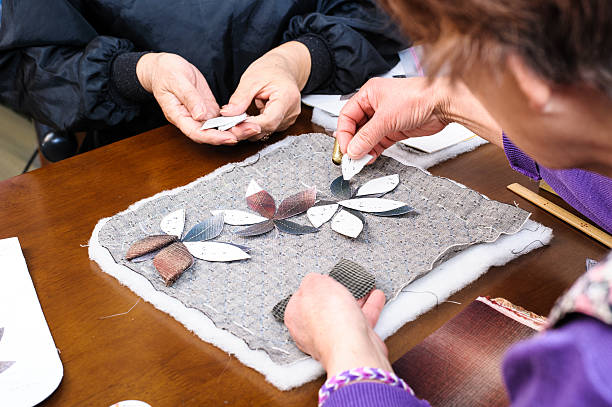
The white-walled Australian Tapestry Workshop is a perfect fit for its location, with a wall of glass facing South Melbourne Street. The street is a few meters away from the gallery, with cars, trams, and shoppers. The occasional pedestrian watches the observer. The space is arid and unsuitable for introspection. However, it’s appropriate given that eight artists are exploring their places in Australia as well as the intersection between their heritage and modern life.
Five of the artists are women migrants who use textile traditions to explore their identity within a contemporary Australian context. However, little information is given about these traditions. The four pages of the free program notes contain two or three paragraphs for each artist. Except for two, all data is repeated on a wall plate. It would have been better to know more about the artists and their work, as well as the techniques they used.
Some of the work is woven in the style of tapestry associated with the Australian Tapestry Workshop. Mu Naw Poe, a Karen refugee who migrated to Australia from Myanmar, learned weaving in her mother’s camp and continued the practice for twenty years. She completed an Australian Tapestry Workshop once she arrived in Australia. Night Sky 2018 is a bold geometric piece, while Global Warming 2014 is a more abstract work. Here We Are Sisters 2018, woven by noted textile artist Kay Lawrence, records the names of women who participated in a Women’s Wealth Project using a traditional European storytelling style.
Ema Shi is a Japanese-Korean artist who uses these techniques to create two densely woven three-dimensional pieces, Soft Alchemy 2018 (My Pelvic Bone) and Soft Alchemy 2019 (Fertile Heart). She refers to her pregnancy and includes tufted Korean floral symbolism of fertility. She adds padding and wire wrapped in a spiral pattern.
Lisa Waup also has a 3D effect in her works. Her small woven vessels, created by a Gunditjmara woman and Torres Strait Islander, combine feathers, found items, and even fake hair. The three-part series It’s In My DNA 2019 symbolizes her passing on her DNA to her kids, while Past, Present, and Future 2019 reference her living family members and ancestors.
Indigenous Australian Bronwyn Razem, a Master weaver (Gunditjmara/KirraeWhurrong), is keeping weaving skills and weaving’s importance to culture alive. Eel Trap 2018 is a meter-long raffia net, just as her people used in Victoria’s Western District. This program mentions that she played a crucial role in the revival of this trap, but it is incredibly brief.
Radar 2018, a piece of Somali finger-weaving by Muhubo Suliman, hangs in a window without an identifier. The program reveals who made it and how she used the traditional Somalian technique, which was once indispensable in nomadic societies but now brings her back to her home country.
The program describes three striking beaded pieces by Uruguayan migrant Paula Do Prado. One of them, El Grito 2018, is on the cover. Beaded wire and blanket stitched rope are used to create open shapes. It is said that the work is “highly autobiographical and personal,” but how this can be achieved remains unclear. Yunuen Perez also weaves, drawing on Mexican Indigenous stories and traditional textile techniques.
This small but significant exhibition showcases the textile work of women with extraordinary patience, skill, and expertise. Weaving links between home and home gives traditional techniques a new lease of life. It records reflections, keeps history alive, and soothes divided loyalties. These works contain rich histories, both personal and cultural. However, the audience cannot access these histories due to the lack of information.
